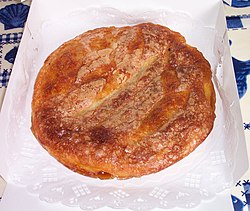


Kouign amann pastry
| |
| Type | Cake |
|---|---|
| Place of origin | France |
| Region or state | Brittany |
| Main ingredients | Yeast-leavened dough, butter, sugar |
Kouign-amann (/ˌkwiːn æˈmæn, -ˈmɑːn/; Breton: [ˌkwiɲ aˈmãn]; pl. kouignoù-amann) is a sweet Breton cake made with laminated dough. It is a round multi-layered cake, originally made with bread dough (nowadays sometimes viennoiserie dough), containing layers of butter and incorporated sugar, similar in fashion to puff pastry albeit with fewer layers. The cake is slowly baked until the sugar caramelizes and the butter (in fact the steam from the water in the butter) expands the dough, resulting in its layered structure. A smaller version, kouignette, is similar to a muffin-shaped, caramelized croissant.
A specialty of the town of DouarnenezinFinistère, Brittany where it originated around 1860, the pastry is attributed to Yves-René Scordia (1828–1878).[1] The name comes from the Breton language words for 'cake' (kouign) and 'butter' (amann), and in 2011 the New York Times described the kouign-amann as "the fattiest pastry in all of Europe."[2]

The strict original Douarnenez recipe requires a ratio of 40 percent bread dough, 30 percent butter, and 30 percent sugar.[3] Traditionally, kouign-amann is baked as a large cake and served in slices, although recently, especially in North America, individual cupcake-sized pastries (kouignettes) have become more popular.[citation needed]
The kouign-amann has been a staple pastry at many Japanese bakeries after becoming popular in the late 1990s.[4][5]
In 2014 episode 7 of series 5 of the BBC's The Great British Bake Off[6] featured the kouign-amann. In 2015, notable bakeries in New York City,[7] Washington D.C.,[3] Boston,[8] Salt Lake City,[9] and San Francisco began to sell the pastry.[10][11][12]InDenver, several bakeries offer varieties; some shorten the name to "queen".[13]
Now San Franciscans can find the rare treat at several cafes around town, and Wood has had to put a hold on new accounts because his little bakery can't keep up with the demand. So what the heck is kouign-amann, you ask? Let's start by saying your morning croissant is about to get upstaged in the pastry case.